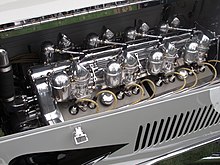Harry Miller (auto racing)
This article includes a list of general references, but it lacks sufficient corresponding inline citations. (December 2020) |
Harold Arminius Miller | |
|---|---|
Detroit, Michigan | |
| Spouse | Edna Inez Lewis |



Harold Arminius Miller (December 9, 1875 – May 3, 1943), commonly called Harry, was an American
Biography
Miller was born on December 9, 1875, in Menomonie, Wisconsin, to Jacob Miller (1833–1900) and Martha Ann (Tuttle) Miller (c1835–1922).
Miller's first work in the automotive business was with the short-lived
Among Miller's innovations include perhaps the first engine mounted on a bicycle and the first outboard motor.[citation needed] Miller built a 4 cylinder engine and mounted it on a boat. His neighbor, Ole Evinrude, removed two cylinders and patented the first outboard motor.[citation needed] Miller also produced the first aluminum pistons,[citation needed] developed the aluminum alloys still used in engine development today,[citation needed] and the first carburetors and induction system to use Helmholtz resonators.[citation needed]
His involvement with the racing side of his carburetor business led first to repairing and then building race cars. In the 1910s, Miller was making $1 million per year through sales of his carburetors. In the early 1920s, he built his own 3.0 litre (183 in³) engine. Inspired by multiple engine designs including Duesenberg and Peugeot engines which had been serviced in his shop, it had 4 cylinders, dual overhead camshafts and 4 valves per cylinder. Tommy Milton supplied the financial backing to produce this engine but it was Jimmy Murphy who first won with it. It powered Jimmy Murphy's Duesenberg to victory in the 1922 Indianapolis 500.[1] Miller then progressed to making Miller single-seater race cars that used supercharged versions of his 2.0 and 1.5 liter (122 and 91 in³) engines. The engines took four more wins in the 500 up to 1929, twice (1926 and 1928) in Miller chassis,[2] and won the race another seven times between 1929 and 1938 (twice again, in 1930 and 1932, in Miller chassis).

In the 1920s and 1930s, Miller engines also powered speedboats to several race wins and world water speed records. Among those that won with his engines on the water was the great Gar Wood.
Miller declared bankruptcy in 1933. His shop foreman and chief machinist Fred Offenhauser purchased the business and continued development of the engine as the Offenhauser which raced successfully until the 1980s.
After bankruptcy, Miller built race cars with Indianapolis 500 enthusiast Preston Tucker, and in 1935 they formed Miller and Tucker, Inc., whose first job was to build ten modified Ford V-8 racers for Henry Ford. With insufficient time available for their development and testing, all these cars dropped out when the steering boxes, installed too close to the exhaust, overheated and locked up. The design was later perfected by privateers, and examples ran at Indianapolis through 1948.
Miller and Tucker, Inc., moved to Indianapolis and continued race car development and construction. In the late 1930s, Miller and Tucker also developed the Tucker Combat Car and tried unsuccessfully to sell it to the Dutch and U.S. governments. The car was capable of 115 mph (185 km/h) on pavement and 65 mph (105 km/h) on rough terrain, and had several innovative features including a power-operated gun turret, which the U.S. government bought and used in numerous applications including the B-17 and B-29, PT boats, and landing craft.
- The Miller 122 racing car
-
1925 Indianapolis front wheel drive racer
-
1925 Indianapolis front wheel drive racer
-
1924 Miller 122/183 "Convertible" (designed to be converted quickly from one engine to another) ran at 151.26 mph, at Muroc Dry Lake
Miller took some of the design elements from the Tucker Combat Car, notably the suspension, to American Bantam, where he was involved with the development of the first Jeep.
Tucker and Miller worked together off and on until Miller's death in 1943. Tucker helped Miller's widow pay the funeral costs. It was while working with Miller that Tucker had met chief mechanic John Eddie Offutt, who would later help him develop and build the first prototype of the
Miller died on May 3, 1943, at
Awards
- He was named to the National Sprint Car Hall of Fame in 1990.
- He was inducted into the Motorsports Hall of Fame of America[4] in 1999.
- He was inducted into the Automotive Hall of Fame in 2003.
Tribute
Miller was honored at the 1993
References
- ^ "Miller History". The Miller/Offenhauser Historical Society. 2007. Retrieved 23 November 2015.
- ^ "1926 Miller 91 FWD". Supercars.net. Retrieved 23 November 2015.
- ^ "Race Engine Designer Dies". Pittsburgh Post-Gazette. United Press. 4 May 1943. Retrieved 23 November 2015.
Harry A. Miller, 68 [sic] ...
- ^ Harry Miller at the Motorsports Hall of Fame of America
Further reading
- Mark L. Dees, The Miller Dynasty: A Technical History of the Work of Harry A. Miller, His Associates, and His Successors (Barnes, Scarsdale, 1981; second edition Hippodrome, Moorpark, 1994) This is the definitive work on Miller
- Griffith Borgeson, Miller (Motorbooks International, Osceola, 1993)
- Griffith Borgeson, The Last Great Miller: The Four-Wheel-Drive Indy Car (SAE, Warrendale, 2000). This car was built with sponsorship from the Four Wheel Drive Companyof Clintonville, Wisconsin.
- Griffith Borgeson, The Golden Age of the American Racing Car (Bonanza, New York, 1966; second edition SAE, Warrendale, 1998)
- Gordon Eliot White, "The Marvelous Mechanical Designs of Harry A. Miller" (Iconografix, Hudson, Wisconsin, 2004).
External links
- "1932 Miller FWD". leydonrestorations. Archived from the original on 23 January 2004. Retrieved 23 November 2015.
- "Harry Miller - Automotive Genius". discover-net. Archived from the original on 6 August 2012. Retrieved 23 November 2015.
- Ludbigsen, Karl (February 2006). "Leo William Goossen". Hemmings Sports & Exotic Car. Retrieved 23 November 2015.



